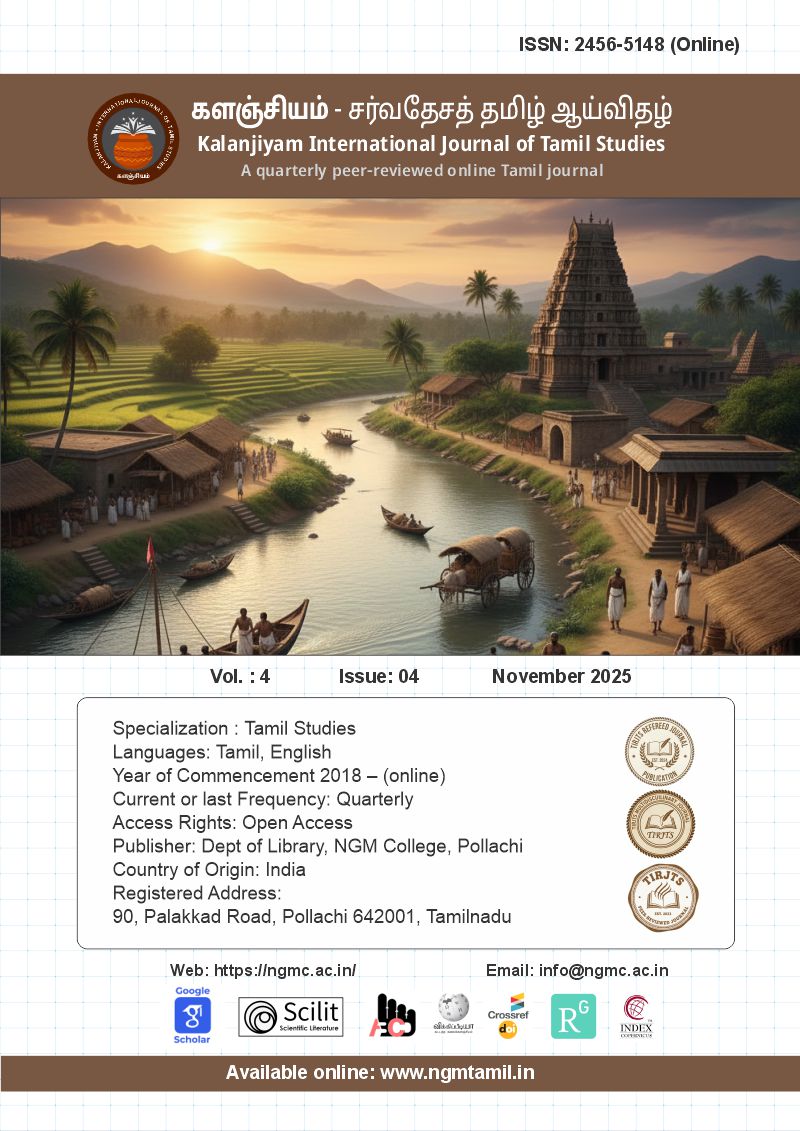குறிஞ்சி நில மக்களின் உணவுப் பண்பாடு
The Food Culture of the Kurinji People
Keywords:
Culture, People, Kurunji People, LifeAbstract
Human societies structure their way of life according to the specific ecological environment they inhabit. This adaptation process has been a continuous phenomenon spanning from ancient times to the present day. Sangam literature meticulously documents the life and culture of the Tamil people by classifying their habitat into five distinct geographical regions (Thinai), detailing the corresponding lifestyles and dietary practices. These regions are defined as: Kurinji (குறிஞ்சி): The mountainous region, Mullai (முல்லை): The forested region, Marutham (மருதம்): Fertile plains and agricultural fields, Neithal (நெய்தல்): The coastal/maritime region, Pālai (பாலை): The dry/arid region (desert-like). An analysis of these five geographical lifestyles clearly reveals that the foodways of the inhabitants possessed unique characteristics specific to their respective thinai. Specifically, this article undertakes a detailed study of the food culture of the Kurinji people—who inhabited the mountainous region and are central to the classification system known as the five Tinais of love (Anbin Ainthinai). Their culinary traditions were deeply intertwined with their natural surroundings and overall way of life, as revealed through the verses of Sangam literature.
This paper explores multiple dimensions of Kurinji food culture, including their daily sustenance, the varieties of grains, tubers, and fruits they consumed, the methods used to prepare animal meat, the specific foods eaten during rituals and festivals, and the broader socio-economic implications of these distinct dietary practices.
மக்கள் தாங்கள் வாழ்கின்ற நில சூழலுக்கு ஏற்றவாறு தம் வாழ்வியலை அமைத்துக் கொள்கின்றனர். இது பண்டைய காலம் தொட்டு இன்றுவரை நடைபெற்றுக் கொண்டிருக்கின்ற ஒரு தொடர்ச்சியான நிகழ்வாகும். சங்க இலக்கியங்கள், தமிழர்களின் வாழ்வியலை ஐந்து வகை நிலங்களாகப் பிரித்து, அதற்கேற்ற வாழ்வியல் முறைகளையும், உணவுப் பழக்கவழக்கங்களையும் விரிவாகப் படம் பிடித்துக் காட்டுகின்றன. இவை குறிஞ்சி (மலை சார்ந்த பகுதி), முல்லை (காடு சார்ந்த பகுதி), மருதம் (வளம் மிகுந்த வயல்வெளிப் பகுதி), நெய்தல் (கடல் சார்ந்த பகுதி), மற்றும் பாலை (பாலைவனம் போன்ற வறண்ட பகுதி) என வரையறுக்கப்பட்டுள்ளன. இந்த ஐவகை நில வாழ்வியலையும் ஆராயும்போது, மக்களின் உணவு முறைகள் அந்தந்தத் திணைக்கே உரிய சிறப்புத்தன்மைகளுடன் இருந்ததை தெளிவாக அறிய முடிகிறது. குறிப்பாக, அன்பின் ஐந்திணைகளில் ஒன்றாகக் கருதப்படும் குறிஞ்சி நில மக்களின் உணவுப் பண்பாடு, அவர்களின் வாழ்க்கை முறையோடும், இயற்கையோடும் பின்னிப் பிணைந்திருந்தது. சங்க இலக்கியப் பாடல்களின் வழி அறியப்பெறும் இந்த தனித்துவமான உணவுப் பண்பாடு குறித்த விரிவான ஆய்வை இக்கட்டுரை மேற்கொள்கிறது. குறிஞ்சி நில மக்களின் அன்றாட உணவுகள், அவர்கள் பயன்படுத்திய தானிய வகைகள், கிழங்குகள், கனிகள், விலங்குகளின் இறைச்சி, அவற்றைத் தயாரிக்கும் முறைகள், சடங்குகளிலும் விழாக்களிலும் அவர்கள் உண்ட உணவுகள், அவற்றின் சமூகப் பொருளாதாரத் தாக்கங்கள் எனப் பல பரிமாணங்களை இக்கட்டுரை அலசுகிறது.
Downloads
References
1. Kapilar. (n.d.). Kuṟiñcippāṭṭu [The Kuṟiñcippāṭṭu]. Pari Nilayam.
2. Kesigan, P. (n.d.). Naṟṟiṇai [The Naṟṟiṇai]. [Commentary by P. Kesigan].
3. Kesigan, P. (n.d.). Tolkāppiyam: Mūlamum Uraiyum [Tolkāppiyam: Text and commentary]. [Commentary by P. Kesigan].
4. Sangam Literature Editorial Board. (n.d.). Kalittokai [The Kalittokai]. [Anthology edited by the Sangam Literature Editorial Board].
5. Subramanian, S. V. (n.d.). Akanaṉūṟu [The Akanaṉūṟu]. [Commentary by S. V. Subramanian].
6. Subramanian, S. V. (n.d.). Aiṅkuṟunūṟu [The Aiṅkuṟunūṟu]. [Commentary by S. V. Subramanian].
7. Subramanian, S. V. (n.d.). Kuṟuntokai [The Kuṟuntokai]. [Commentary by S. V. Subramanian].
8. Subramanian, S. V. (n.d.). Malaipaṭukaṭām [The Malaipaṭukaṭām]. [Commentary by S. V. Subramanian].
Downloads
Published
Issue
Section
License
Copyright (c) 2025 S.Anandha Shainy, முனைவர் சௌ. கீதா (Author)

This work is licensed under a Creative Commons Attribution 4.0 International License.
Our journal adopts CC BY License Creative Commons Attribution 4.0 International License http://Creativecommons.org//license/by/4.0/ . It allows using, reusing, distributing and reproducing of the original work with proper citation.


